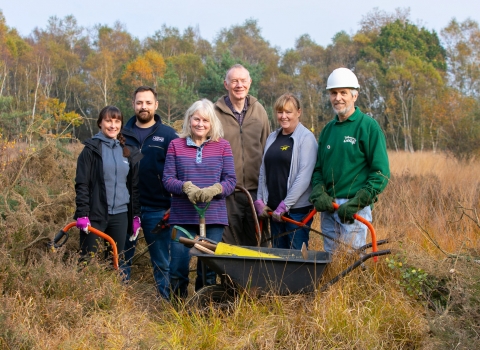When Elaine joined us, she knew she liked conservation and nature but wasn’t sure about what she would do after university. We sat down together and discussed some potential projects she could get involved with. We made sure she could get involved in a range of different projects to give her a really broad experience to introduce her to the conservation sector.
Volunteering with the Trust: Elaine's story
Elaine started off by developing her practical conservation skills and joined in with numerous different volunteer groups. This gave her the opportunity to learn more about practical habitat management and put into practice some of the things she had learnt during her degree. She also attended some of the Hedgerow Heritage Project practical sessions where she got the opportunity to plant a hedge and learnt how to lay a hedge. These sessions supported the Trust’s goals to connect and improve nature but also allowed Elaine the opportunity to learn more about Surrey’s nature and develop her skillset.
As part of her placement, Elaine also spent time with the Education team at Nower Wood, developing her engagement skills and gaining experience of working with children. She supported self-guided visits, helped with tutor-led sessions and supported events. Elaine also supported with some event organisation and helped to deliver the Wild Surrey Art and Photography Exhibition at the Lightbox in Woking. Elaine also had the chance to develop her GIS skills through supporting with the Hedgerow Heritage Project. She mapped out hedges using aerial imagery which volunteers could then go out and survey on the ground.
After Elaine had been with us for 4 months, she started a research project, chosen from the Research and Monitoring Prospectus. She looked at the Surrey Wildlife Trust conservation volunteering offer and whether it fulfils the criteria to be described under the banner of green social prescribing. She conducted interviews and focus groups with a variety of the regular practical conservation groups and then the reported activities and benefits are then compared with established recommendations for improving wellbeing. The future marketing of the volunteering offer was considered, together with recommendations to widen participation and improve suitability for those with more specific mental health needs. The report has now been shared with the Trust to review how the volunteering opportunity could be used as green social prescribing.
Elaine finished her placement by completing a university report where she reflected on her placement and detailed all the skills she developed. She reflects for us here:
“Taking a year out from my studies to focus on a practical placement helped me to discover my motivations and the types of work I really enjoy. I gained a realistic understanding of both practical conservation roles and public engagement. I particularly enjoyed Events and Marketing roles, which I was also engaged in as a Student Ambassador for my university during the year. This experience gave me insights into areas of work I had not previously considered, as well as transferable skills. I also gained plenty of specific skills and knowledge for the conservation sector which are not covered by my geography degree programme, such as species identification and use of hand tools to complete a range of practical tasks. I found it rewarding to complete a research project whose findings would be used to make genuine improvements for volunteers, and I learned a lot about the links between nature and wellbeing. Finally, the placement gave me plenty of networking opportunities both within and beyond the organisation. There are several areas of work which interest me so for now I am keeping an open mind, but I am confident that I will be able to find a rewarding role in the future.”
Thank you Elaine for all your hard work during your placement!
Written by Esther Hill
Community Engagement Officer


